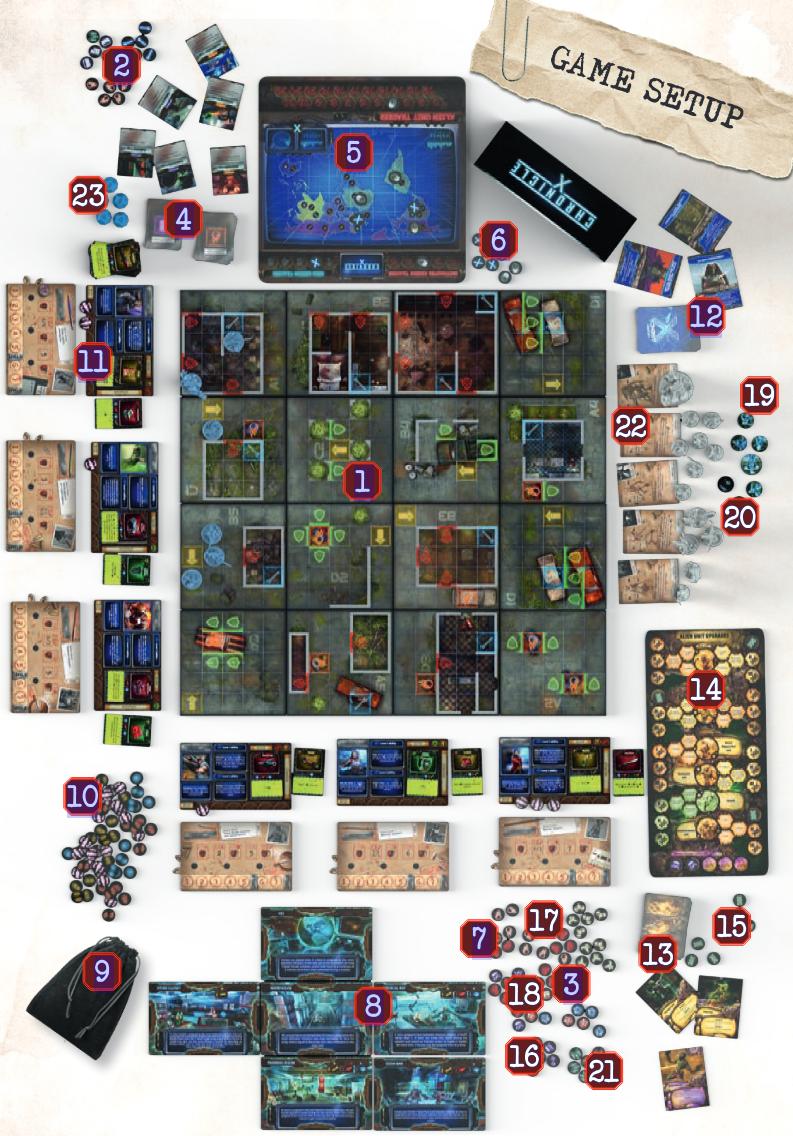Component Overview
When you set up Chronicle X on the table, the setup may look something like this:

(Note: for illustrative purposes, a few components are shown in a different position than they would have at the start of a game; for example, a few of the Hero minis shown in the image are not in their starting positions, and the Space Station contains more cards than it has from the start.)
1. The Mission Map, consisting of Map Tile. This is the terrain which players will traverse when playing Missions.
2. Building, Hazard and Spanner tokens. These are placed on the Map Tiles when the Mission Map is setup. Hazard and Spanner tokens are placed one on each map Square with a corresponding icon (orange flame for Hazard, blue Spanner/Wrench for Spanner. Building exploration tokens are placed one per building building.
3. Mission Marker tokens. Certain Missions will require players to Interact with or move to Mission Markers.
4. Hazard and Building decks. Cards are drawn from these decks when players destroy Hazards or explore Buildings.
5. The Global Operation Map, also known as World Map, is mainly used in Conquest Mode, although the Alien Unit tracker is also located on this board.
6. Team Symbol tokens, used in Conquest Mode to keep track of which Regions on the World Map are controlled by which team (Hero Players or Overmind Player).
7. Fortified tokens. Used only in Conquest Mode; each team may "fortify" one Region they control.
8. Space Station cards.
9. Item bag. A curiosity left over from an earlier game design stage when Items where tokens rather than cards; they were then drawn randomly from this bag. After Items where changed to be cards, it is easier to draw them from the bottom of their deck (since the cards are double sided, so drawing from the top it would be visible which the next card to draw is). (I guess Archon felt they had promised Kickstarter backers a cloth bag during the campaign, so they included one in the final product even if it's no longer needed.)
10. Resource and Neon Rush tokens. Exchange Items for valuable Resources and energy drinks.
11. Hero Profile cards and Hero Dials. Each Hero has unique abilities and stats included on their Hero Profile card, and the Hero Dials keep track of their changing stats.
12. Hidden Agenda deck. These usually provide the Mission objectives for the Overmind Player.
13. Forced/Ultimate Mutation cards. These cards can be played more or less at any time (subject to whatever limitations are written on the cards, and what specific situations they have an effect in) by the Overmind Player.
14. Alien Upgrade Sheet. This shows all players what Upgrade Nodes the Overmind Player has acquired.
15. Upgrade Nodes. The tokens used to mark acquired upgrades on the Alien Upgrade Sheet.
16. Abduction tokens. The Overmind Player earns these during the game. The are similar to Experience Points gained by the Heroes.
17. Damage tokens. These are used to track the health of each Alien Unit. They can either be placed next to the unit on the Mission Map, or for Alien Units where only a single unit is on the map, on the corresponding Alien Profile card.
18. Overwatch tokens. Double-sided tokens to indicate when a model is in Overwatch mode.
19. Blip Tokens. These represent the Alien Forces before the Heroes have discovered exactly what Alien Types they are.
20. VIP Blip Tokens. Some Missions will require the Hero Players to locate hidden VIP characters.
21. Reinforcement tokens. These show how many Reinforcements the Overmind Player can play.
22. Alien Profile cards. Each Alien Unit will have unique abilities and profiles indicated on their Alien Profile cards.
23. Combat dice. These are used when Attacking or Defening.
For an overview of game components for the Expansions, see the main pages for those: TWILIGHT AT AREA 51 and ABYSS.